Hey there, fellow budding artist! So, you’ve decided to dip your toes into the colorful world of acrylic painting—bravo!
Whether you’re picking up a brush for the first time or looking to refine your skills, you’ve come to the right place. Even if you’re a complete beginner, there’s no need to feel intimidated.
With these 8 helpful tips below and a willingness to learn, you’ll soon be on your way to creating your own masterpiece that you can be proud of. So, grab your brushes and let’s dive in!
#1 Adjust your water consistency
Adjusting the water consistency in acrylic painting is like finding the right balance for a recipe – too much or too little can throw off the whole dish… or painting, in this case! Start with a little water and gradually add more until you reach the desired consistency. You want it to flow smoothly, almost like cream, but not be too thin that it loses its vibrancy and runs all over the place – or too thick that it’s difficult to work with.
Start with a little water and gradually add more until you reach the desired consistency. You want it to flow smoothly, almost like cream, but not be too thin that it loses its vibrancy and runs all over the place – or too thick that it’s difficult to work with.
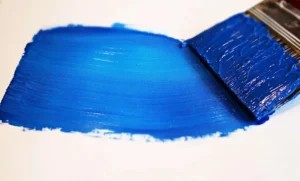
It’s a bit of trial and error, but once you get the hang of it, it becomes second nature. Plus, different techniques and styles might call for slightly different consistencies, so it’s all about experimenting and finding what works best for you. By practicing and experimenting regularly, you’ll become more confident in achieving the perfect water consistency for your acrylic painting
#2 Use Synthetic brushes
Opting for synthetic brushes when working with acrylic paints is a smart move for several reasons. Their synthetic bristles are neither too soft and bendy nor too stiff and are crafted to withstand the medium-bodied consistency of acrylic paints.
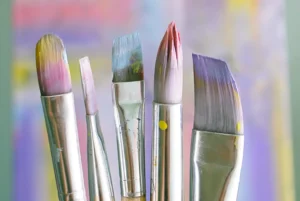
Synthetic bristles are durable and resilient, maintaining their shape and performance over time, even with frequent use and cleaning. Also, they are typically more affordable than their natural hair counterparts, making them a practical choice for artists on a budget. With their versatility, durability, and cost-effectiveness, synthetic brushes are indeed the ideal choice for acrylic painting.
#3 Explore Color Mixing
Mixing colors is a crucial aspect of painting that often carries more weight than one might initially realize. While we may just want to apply the paint directly from the tube onto the canvas in the beginning – it is good to slowly develop an eye for achieving the exact hue of the object in your reference image that you’re trying to paint. This is very helpful in attempting realistic paintings- like landscapes.
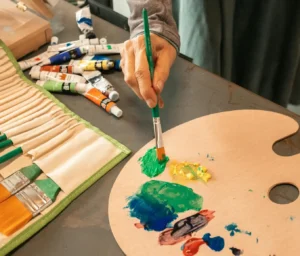
By carefully blending your colors, you can create depth, dimension, and nuance in your artwork, adding richness and complexity to your paintings. So, don’t rush the process – play around with mixing, experimenting, and refining until you achieve just the right hue. Only when you’re happy with the color in your palette should you then apply it to your canvas.
#4 Clean Your Brush Well Between Colors
Cleaning your brush between color changes is a crucial step in painting to ensure that colors remain true and don’t mix unintentionally.
Start by gently scraping off excess paint using the palette edge or a paper towel. Then, swish it thoroughly in your jar of water. Finally, gently pat the brush dry on a cloth or paper towel. These steps are usually enough for a clean color change using one brush.
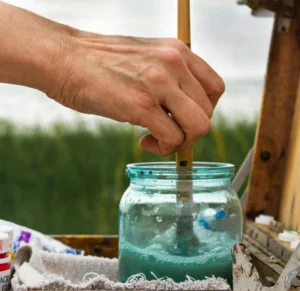
It is useful to keep two separate water jars – one for cleaning your brush during a color change and the other for adding water to get the right paint consistency.
#5 Use A Reference Image
Painting from memory can indeed be a bit like navigating in the dark—you might miss some crucial details or veer off course without even realizing it.
You might also quickly realize that you don’t really know the object quite as well as you thought you did! While memory can be a great source of inspiration, relying solely on it for your paintings can limit your creativity and accuracy. Instead, it’s often best to paint from life or reference photos, especially when you’re aiming for realism or specific details. This allows you to capture the subject’s nuances, textures, and lighting more accurately and also hone your skills.
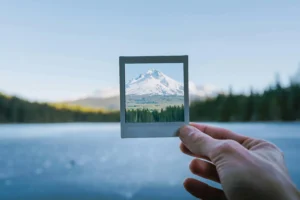
You can find loads of reference images on the internet. Choose one that is clear, that inspires you and that has the level of detail that you want to try.
#6 Don’t Worry About Making Mistakes
One of the best things about painting in acrylics is that it is very forgiving if you make mistakes – you can just easily paint over it! And you don’t even have to wait long to do to it because they dry very fast!
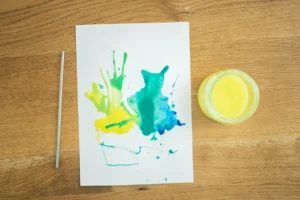
Knowing this should give you the confidence to take a risk or try a new technique in your artwork. So embrace all those mistakes – they truly are a natural part of the artistic process, and learning how to correct them effectively is an essential skill for any artist.
#7 Look At Your Painting From A Distance
Make it a habit to regularly step back and observe your painting from a couple of feet away. Stepping back gives you a fresh viewpoint allowing you to gauge the proportions and scale of your painting more accurately. It helps you identify any areas that may be too large, too small, or out of proportion. You can also evaluate the balance of colors and notice details that might not be apparent up close.
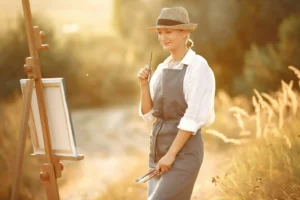
It’s a simple but effective way to improve your work and ensure that you’re on the right track.
#8 Work In Layers
Building up paint layers is simply the process of applying multiple layers of paint on top of each other to create more dimension, and complexity in your artwork .
Layering paint adds depth to your artwork by creating the illusion of three-dimensional space. By varying the opacity and color of each layer, you can create subtle transitions and gradients that give your painting depth and dimension.
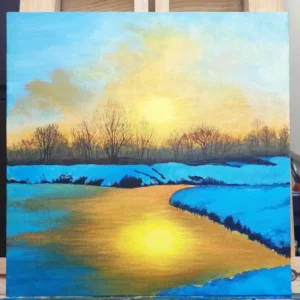

I hope you found these tips useful. Remember, the most important thing is to have fun and enjoy the process of creating art.
Don’t be discouraged if your early attempts don’t turn out as you’d hoped—every artist starts somewhere! Keep practicing, keep learning, and most importantly, keep painting!
